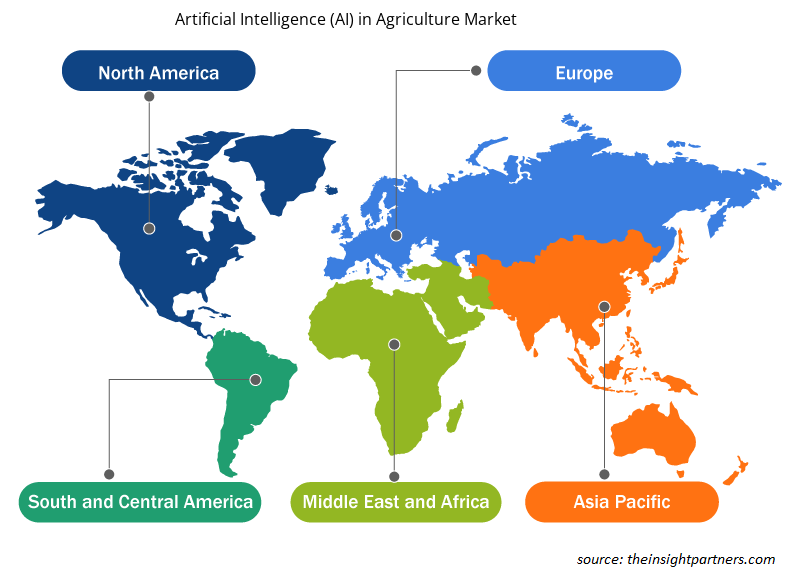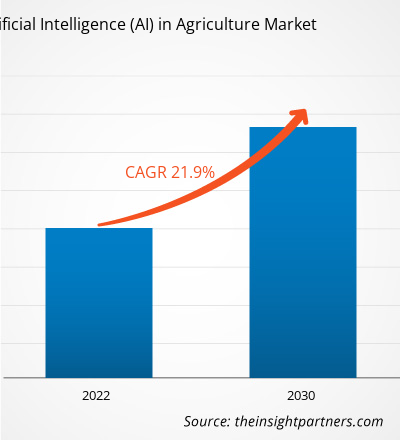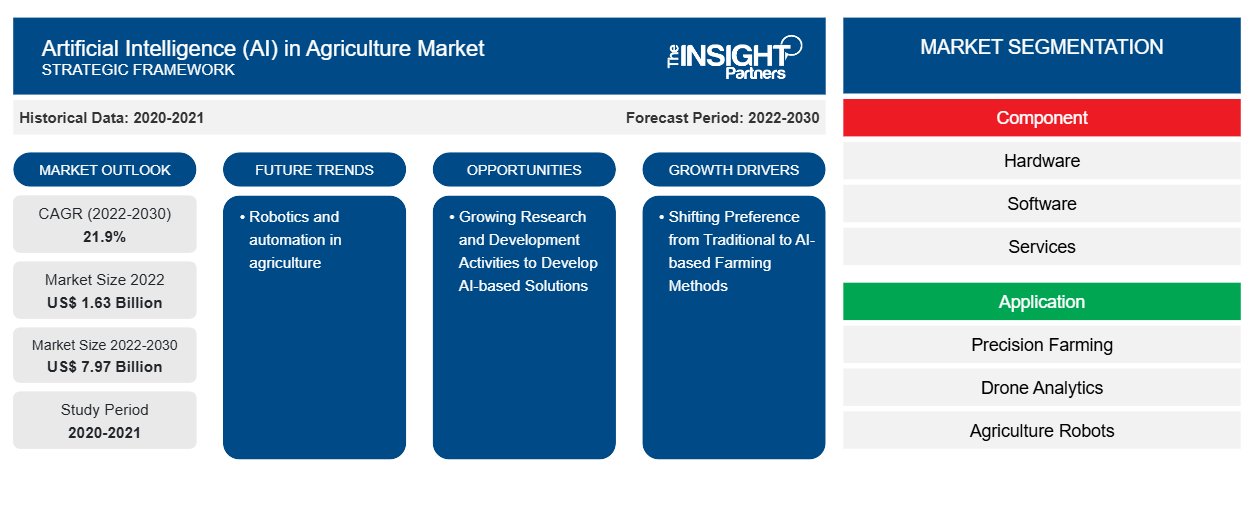تم تقييم حجم سوق الذكاء الاصطناعي في الزراعة بنحو 1.63 مليار دولار أمريكي في عام 2022 ومن المتوقع أن يصل إلى 7.97 مليار دولار أمريكي بحلول عام 2030؛ ومن المتوقع أن يسجل معدل نمو سنوي مركب بنسبة 21.9٪ من عام 2022 إلى عام 2030. ومن المرجح أن تظل الروبوتات والأتمتة في الزراعة من الاتجاهات الرئيسية في السوق.
تحليل سوق الذكاء الاصطناعي في الزراعة
إن التحول من التفضيلات التقليدية إلى أساليب الزراعة القائمة على الذكاء الاصطناعي، والاستخدام المتزايد للطائرات بدون طيار في الزراعة، والحاجة المتزايدة إلى التحليلات في الوقت الفعلي في الزراعة هي عوامل تدفع السوق. ومن المتوقع أن ينمو السوق خلال فترة التوقعات، بسبب الدعم الحكومي المتزايد لتنفيذ حلول الذكاء الاصطناعي. وعلاوة على ذلك، فإن أنشطة البحث والتطوير المتزايدة لتطوير حلول تعتمد على الذكاء الاصطناعي وزيادة الزراعة الذكية تخلق فرصًا مربحة للسوق.
نظرة عامة على سوق الذكاء الاصطناعي في الزراعة
يحدث الذكاء الاصطناعي ثورة في صناعة الزراعة. تساعد التحليلات التنبؤية والرؤية الحاسوبية والتعلم الآلي وتحليلات البيانات الزراعة على التغلب على العقبات وتحقيق إمكاناتها الكاملة. يسمح استخدام الذكاء الاصطناعي في الزراعة بجمع البيانات وتحليلها من مجموعة متنوعة من المصادر، بما في ذلك ظروف التربة وأنماط الطقس وصحة المحاصيل والبيانات التاريخية.
يمكن للأنظمة القائمة على الذكاء الاصطناعي أن تزود المزارعين بمعلومات قيمة لزيادة الغلة، والحد من النفايات، وتقليل المخاوف البيئية. ويمكن للمزارعين وأصحاب المصلحة استخدام الرؤى القائمة على البيانات واتخاذ القرارات الذكية لتعزيز الإنتاجية، وتحسين استخدام الموارد، والتعامل مع القضايا الزراعية. ويمكن استخدام الآلات الذكية والروبوتات لأتمتة المهام الرتيبة في الزراعة. وتساعد هذه التطورات المزارع على معالجة نقص القوى العاملة والتركيز على التخطيط والإدارة الاستراتيجية.
قم بتخصيص هذا التقرير ليناسب متطلباتك
ستحصل على تخصيص لأي تقرير - مجانًا - بما في ذلك أجزاء من هذا التقرير، أو تحليل على مستوى الدولة، وحزمة بيانات Excel، بالإضافة إلى الاستفادة من العروض والخصومات الرائعة للشركات الناشئة والجامعات
-
احصل على أهم اتجاهات السوق الرئيسية لهذا التقرير.ستتضمن هذه العينة المجانية تحليلاً للبيانات، بدءًا من اتجاهات السوق وحتى التقديرات والتوقعات.
الذكاء الاصطناعي في الزراعة: العوامل المحركة والفرص المتاحة
التحول من التفضيلات التقليدية إلى أساليب الزراعة القائمة على الذكاء الاصطناعي
واجه مزارعو البطاطس التقليديون في جميع أنحاء كندا تحديات في إدارة المغذيات، وهو جانب حاسم من الزراعة يؤثر بشكل مباشر على غلة المحاصيل. إن الطرق التقليدية لمعالجة التربة والتغذية الورقية، على الرغم من فعاليتها إلى حد ما، لها قيود، خاصة فيما يتعلق بالمغذيات المطلوبة في المراحل اللاحقة من نمو البطاطس. وبالتالي، ينشر مزارعو البطاطس في جميع أنحاء كندا حلول الذكاء الاصطناعي للتنبؤ بالاحتياجات الغذائية لنبات البطاطس. على سبيل المثال، في نوفمبر 2023، مع التطورات الرائدة في القطاع الزراعي، يتجه مزارعو البطاطس الكنديون إلى الذكاء الاصطناعي لمراقبة وتوقع الاحتياجات الغذائية لمحاصيلهم في الوقت الفعلي. وبالتالي، فإن اعتماد المزارعين الكنديين للذكاء الاصطناعي يدفع نمو الذكاء الاصطناعي في سوق الزراعة.
تزايد أنشطة البحث والتطوير لتطوير حلول تعتمد على الذكاء الاصطناعي
تتميز المملكة المتحدة بقدرات بحثية وتكنولوجية عالمية المستوى وهي الرائدة عالميًا في تطوير الحلول التي تعتمد على الذكاء الاصطناعي. علاوة على ذلك، يستخدم الباحثون في المملكة المتحدة الذكاء الاصطناعي لإحداث ثورة في الصناعات التقليدية مثل الزراعة. وفقًا لبيانات يناير 2024، يحاول الباحثون في جامعة هاربر آدامز جعل الزراعة أكثر استدامة وإنتاجية باستخدام الذكاء الاصطناعي.
كما أعلنت حكومة المملكة المتحدة عن تمويل بقيمة 39.82 مليون دولار أمريكي لدعم تطوير مشاريع الذكاء الاصطناعي في قطاعات متنوعة مثل الزراعة والأزياء وخدمات الطوارئ. كما تم منح 5.38 مليون دولار أمريكي إضافية لدراسات الجدوى لـ 100 مشروع من الشركات الصغيرة، وتعزيز أفكار الذكاء الاصطناعي المبتكرة لتعزيز الإنتاجية في مختلف القطاعات. وبالتالي، من المتوقع أن يعمل هذا الدعم الحكومي على دفع نمو الذكاء الاصطناعي في سوق الزراعة.
تقرير تحليل تجزئة سوق الذكاء الاصطناعي في الزراعة
إن القطاعات الرئيسية التي ساهمت في استخلاص تحليل سوق الذكاء الاصطناعي في الزراعة هي المكونات والتطبيقات.
- بناءً على المكون، ينقسم سوق الذكاء الاصطناعي في الزراعة إلى أجهزة وبرامج وخدمات. احتل قطاع الأجهزة حصة سوقية أكبر في عام 2022.
- من حيث التطبيق، ينقسم السوق إلى الزراعة الدقيقة ، وتحليلات الطائرات بدون طيار، والروبوتات الزراعية، ومراقبة الماشية، وغيرها. احتل قطاع الزراعة الدقيقة حصة سوقية أكبر في عام 2022.
تحليل حصة سوق الذكاء الاصطناعي في الزراعة حسب المنطقة الجغرافية
ينقسم النطاق الجغرافي لتقرير سوق الذكاء الاصطناعي في الزراعة بشكل أساسي إلى خمس مناطق: أمريكا الشمالية، وآسيا والمحيط الهادئ، وأوروبا، والشرق الأوسط وأفريقيا، وأمريكا الجنوبية والوسطى.
من المتوقع أن يتوسع السوق في منطقة آسيا والمحيط الهادئ خلال فترة التنبؤ، بسبب الطلب المتزايد على الحلول المتقدمة تقنيًا. في دول مثل أستراليا، حيث تتقدم القوى العاملة الزراعية في السن بسرعة، فإن الطلب على العمالة الماهرة أكبر من أي وقت مضى. الزراعة، مع تكاملها مع التكنولوجيا المتطورة مثل الذكاء الاصطناعي والتعلم الآلي، تحمل المفتاح لسد هذه الفجوة وإدخال الزراعة إلى العصر المعاصر. يشهد العديد من المزارعين الأستراليين بالفعل فوائد الأنظمة التي تعمل بالذكاء الاصطناعي. على سبيل المثال، في أكتوبر 2023، نشرت شركة Sunray Strawberries في Wamuran نظام المراقبة الآلي DeepBerry؛ يستخدم النظام كل من التصوير المرئي والأشعة تحت الحمراء للكشف بدقة عن النضج والكدمات والفطريات وحجم الفاكهة وشكلها والأجسام الغريبة. يمكنه معالجة أكثر من 7000 حبة غونيت في الساعة. إن تنفيذ مثل هذه الأنظمة الآلية يدفع نمو الذكاء الاصطناعي في سوق الزراعة.
الذكاء الاصطناعي في سوق الزراعة: رؤى إقليمية
لقد قام المحللون في Insight Partners بشرح الاتجاهات والعوامل الإقليمية المؤثرة على سوق الذكاء الاصطناعي في الزراعة طوال فترة التنبؤ بشكل شامل. يناقش هذا القسم أيضًا قطاعات سوق الذكاء الاصطناعي في الزراعة والجغرافيا في جميع أنحاء أمريكا الشمالية وأوروبا ومنطقة آسيا والمحيط الهادئ والشرق الأوسط وأفريقيا وأمريكا الجنوبية والوسطى.

- احصل على البيانات الإقليمية المحددة للذكاء الاصطناعي (AI) في سوق الزراعة
نطاق تقرير سوق الذكاء الاصطناعي في الزراعة
| سمة التقرير | تفاصيل |
|---|---|
| حجم السوق في عام 2022 | 1.63 مليار دولار أمريكي |
| حجم السوق بحلول عام 2030 | 7.97 مليار دولار أمريكي |
| معدل النمو السنوي المركب العالمي (2022-2030) | 21.9% |
| البيانات التاريخية | 2020-2021 |
| فترة التنبؤ | 2022-2030 |
| القطاعات المغطاة |
حسب المكون
|
| المناطق والدول المغطاة |
أمريكا الشمالية
|
| قادة السوق وملفات تعريف الشركات الرئيسية |
|
كثافة اللاعبين في سوق الذكاء الاصطناعي في الزراعة: فهم تأثيره على ديناميكيات الأعمال
يشهد سوق الذكاء الاصطناعي في الزراعة نموًا سريعًا، مدفوعًا بالطلب المتزايد من المستخدم النهائي بسبب عوامل مثل تفضيلات المستهلكين المتطورة والتقدم التكنولوجي والوعي الأكبر بفوائد المنتج. ومع ارتفاع الطلب، تعمل الشركات على توسيع عروضها والابتكار لتلبية احتياجات المستهلكين والاستفادة من الاتجاهات الناشئة، مما يعزز نمو السوق.
تشير كثافة اللاعبين في السوق إلى توزيع الشركات أو المؤسسات العاملة في سوق أو صناعة معينة. وهي تشير إلى عدد المنافسين (اللاعبين في السوق) الموجودين في مساحة سوق معينة نسبة إلى حجمها أو قيمتها السوقية الإجمالية.
الشركات الكبرى العاملة في سوق الذكاء الاصطناعي في الزراعة هي:
- شركة تول للتكنولوجيا
- شركة بريسيجن هوك
- إيزي تو سي أغ تيك إس إل
- ديري وشركاه
- شركة المناخ المحدودة
- جامايا إس إيه
إخلاء المسؤولية : الشركات المذكورة أعلاه ليست مرتبة بأي ترتيب معين.

- احصل على نظرة عامة على أهم اللاعبين الرئيسيين في سوق الذكاء الاصطناعي في الزراعة
الذكاء الاصطناعي في سوق الزراعة – أخبار وتطورات حديثة
يتم تقييم سوق الذكاء الاصطناعي في الزراعة من خلال جمع البيانات النوعية والكمية بعد البحث الأولي والثانوي، والتي تتضمن منشورات الشركات المهمة وبيانات الجمعيات وقواعد البيانات. فيما يلي بعض التطورات في سوق الذكاء الاصطناعي في الزراعة:
- أعلنت شركة Chipotle Mexican Grill عن استثمارات أقلية في شركتي Greenfield Robotics وNitricity. سيساعد الاستثمار من Chipotle شركة Greenfield Robotics على توسيع أسطولها وتطوير قدرات إضافية لروبوتاتها، مثل الرش الدقيق وزراعة المحاصيل الغطائية واختبار التربة. (المصدر: Chipotle Mexican Grill، موقع الشركة على الويب، ديسمبر 2023).
تغطية تقرير سوق الذكاء الاصطناعي في الزراعة والنتائج المتوقعة
يقدم تقرير "حجم سوق الذكاء الاصطناعي (AI) في الزراعة وتوقعاته (2020-2030)" تحليلاً مفصلاً للسوق يغطي المجالات التالية:
- حجم سوق الذكاء الاصطناعي في الزراعة وتوقعاته على المستويات العالمية والإقليمية والوطنية لجميع قطاعات السوق الرئيسية التي يغطيها النطاق
- اتجاهات سوق الذكاء الاصطناعي في الزراعة بالإضافة إلى ديناميكيات السوق مثل المحركات والقيود والفرص الرئيسية
- تحليل مفصل لقوى PEST/Porter الخمس وSWOT
- تحليل سوق الذكاء الاصطناعي في الزراعة يغطي اتجاهات السوق الرئيسية والإطار العالمي والإقليمي واللاعبين الرئيسيين واللوائح والتطورات الأخيرة في السوق
- تحليل المشهد الصناعي والمنافسة الذي يغطي تركيز السوق، وتحليل خريطة الحرارة، واللاعبين البارزين، والتطورات الأخيرة في سوق الذكاء الاصطناعي في الزراعة
- ملفات تعريف الشركة التفصيلية
- التحليل التاريخي (سنتان)، سنة الأساس، التوقعات (7 سنوات) مع معدل النمو السنوي المركب
- تحليل PEST و SWOT
- حجم السوق والقيمة / الحجم - عالمي، إقليمي، بلد
- الصناعة والمنافسة
- مجموعة بيانات إكسل
التقارير الحديثة
شهادات العملاء
سبب الشراء
- اتخاذ قرارات مدروسة
- فهم ديناميكيات السوق
- تحليل المنافسة
- رؤى العملاء
- توقعات السوق
- تخفيف المخاطر
- التخطيط الاستراتيجي
- مبررات الاستثمار
- تحديد الأسواق الناشئة
- تحسين استراتيجيات التسويق
- تعزيز الكفاءة التشغيلية
- مواكبة التوجهات التنظيمية























 احصل على عينة مجانية ل - الذكاء الاصطناعي في سوق الزراعة
احصل على عينة مجانية ل - الذكاء الاصطناعي في سوق الزراعة